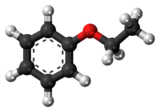|
Ethyl phenyl ether
Ethyl phenyl ether (or phenetole) is an organic compound that belongs to a class of compounds called ethers. Ethyl phenyl ether has the same properties as some other ethers, such as volatility, explosive vapors, and the ability to form peroxides. It will dissolve in less polar solvents such as ethanol or ether, but not in polar solvents such as water.[1] PreparationEthyl phenyl ether can be prepared by the reaction of phenol with diethyl sulfate:
This reaction follows SN2 path.[citation needed] See alsoNotes
Additional references
|
||||||||||||||||||||||||||||||||||||||||||||||||||||||

